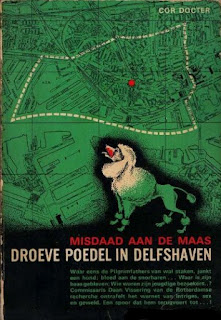"You had those typical neighborhood murder cases, with the remarkable intimacy of a John Dickson Carr story or Agatha Christie's train murder... This seemed such a closed ward murder, bound to the invisible walls of the rayon."- Commissioner Daan Vissering (Droeve poedel in Delfshaven, 1970)
Earlier
this month, I reviewed Koude vrouw in Kralingen (Cold Woman in
Kralingen, 1970) by Cor Docter, a pulp writer who had a trilogy of
full-fledged detective novels to his credit that merged the style of the Dutch
topographical police story with the type of fantastic plots usually found in
the most imaginative works of John Dickson Carr and Ellery Queen, and flung in
an seemingly impossible situation for good measure. Needless to say, I was
intrigued, even if some parts of the solution gave pause for thought, and now I
feel even more drawn to his work after finishing Droeve poedel in Delfshaven
(Melancholic Poodle in Delfshaven, 1970).
Melancholic
Poodle in Delfshaven
opens with the muffled howls of a dog, muzzle smeared with blood and a trail of
identical substance leading to the doorsteps of a house abandoned by its owner.
Commissioner Daan Vissering is holding the leash of the investigation and he
and his team begin to sniff around for clues.
The
missing homeowner is one Gerrit Vledser, a shady moneylender, who, according to
the evidence, was hit over the head with the dog’s food bowl – before he was
either taken away or fled from his attacker(s). They find a hand drawn map,
with markings, and Vissering drags information from the neighbor that includes
shreds of a heated conversation, the time Vledser may have been hit and two
young men who associated with him. More than enough to go on, but other
problems are emerging that ask for the commissioner's attention.
Exploding
fireworks cloak the statue of Admiral Piet Hein in smoke, noise and confusion.
Somewhere else, an exploding smoke bomb has the same effect. Senseless pranks
or is there a darker meaning? Vissering has his own thoughts about it and
suspects a connection, which is confirmed when the young men turn up and knock
one of his men, Grijphand, into the hospital. And before long, Vledser turns up
again. Behind the statue of Van 't Hoff. His head caved in... again!
 |
| Scene of the Crime: Van 't Hoff statue |
Melancholic
Poodle progresses
in the same, absolutely delightful, way as Cold Woman, thickening the
plot with each succeeding chapter, however, I found this to be less of a
throwback than the other one – which dribbed with the influences from Anthony Abbot, John Dickson Carr and S.S. van Dine. Not that I have any complaints
about that, but the publisher advertised this series as classic detective stories
reinvented and this book definitely felt like it delivered on that promise.
There was, for one, more emphasize on characters, or, at least, a series of interesting character portraits. One of them told the story of one of those many, and often forgotten, tragedies from the war, but even more interesting was the back story of Grijphand. Docter only needed a few pages to make you understand what made that man tick instead of drawing those events from his youth out over a couple of hundred pages. It was just a pleasant balance between plot and character. Although, there may have been a tad bit more plot than character.
There was, for one, more emphasize on characters, or, at least, a series of interesting character portraits. One of them told the story of one of those many, and often forgotten, tragedies from the war, but even more interesting was the back story of Grijphand. Docter only needed a few pages to make you understand what made that man tick instead of drawing those events from his youth out over a couple of hundred pages. It was just a pleasant balance between plot and character. Although, there may have been a tad bit more plot than character.
The plot
unfolds at a slow, methodical pace, peppered with a suspenseful wrap-up of one
of their problems, before the murderer is confronted in a classic denouement
and receives a lecture from Vissering on the Chesterton-effect – which is nothing
short of brilliant. Yes. The identity of the murderer is a revelation in the best
GAD tradition, but with a decidedly modern touch.
Docter showed a skillful hand
at tying all the plot threads together and make it logically click on every
layer of the story. All in
all, a very fun and clever detective story to read.


Are these books hard to come by actually? I will have to pick them up when I'm back in the country again...
ReplyDeleteThey're not rare, or anything, but I have seen some overpriced copies floating around. At least, I would not pay 10 euros for a paperback, when you can get one for more than the half less.
DeleteI advice to look around a bit and recommend you start with this one. You will love the solution!
Thanks!
DeleteOh, and because I don't think I'll post this week, but I do think that more people should know about this: Shimada Souji confirmed on his twitter account that a translation of his novelette [i]P no Misshitsu[/i] will feature in next February's EQMM ;)